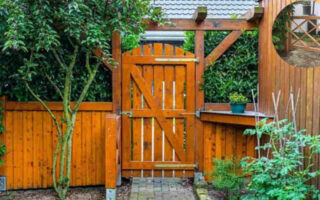A beautiful, functional garden is every homeowner’s dream. But what happens when your garden isn’t level? Uneven or sloped gardens can be frustrating to manage, making it difficult to plant, build, or even enjoy outdoor activities. Whether you’re dealing with water pooling, soil erosion, or simply a lack of usable space, levelling your garden can solve these challenges and create a more inviting outdoor environment.
One of the most effective and versatile solutions for levelling and landscaping a garden is the use of garden sleepers. These sturdy beams, often made from wood, concrete, or composite materials, offer an aesthetically pleasing and durable way to transform uneven terrain into a well-structured and attractive space. From creating retaining walls to building raised beds, sleepers are a game-changer when it comes to garden design.
Understanding the Need to Level Your Garden
Why Does Garden Leveling Matter?
A level garden is not just about appearances—it’s about functionality and health. Uneven gardens can lead to several issues, such as:
- Poor Drainage: Water pooling in low spots can drown plants and encourage pests.
- Erosion: Sloped gardens are prone to soil erosion, which can strip away nutrients and damage plants.
- Difficult Maintenance: Mowing, planting, and other garden tasks become much harder on uneven terrain.
- Limited Usability: Uneven surfaces reduce the usable space in your garden, making it less enjoyable for outdoor activities.
A level garden improves usability, enhances plant health, and creates opportunities for creative landscaping.
Common Leveling Methods
Traditional garden levelling methods include adding or removing soil, creating terraces, and installing retaining walls. However, using garden sleepers stands out as a top choice because of their durability, versatility, and aesthetic appeal. Sleepers not only solve levelling issues but also add structure and style to your outdoor space—making them a preferred option for many homeowners.
What Are Sleepers and Why Use Them?
What Are Garden Sleepers?
Garden sleepers are long, rectangular beams traditionally used in railway construction but are now widely repurposed for landscaping purposes. They come in various materials, including:
- Wooden Sleepers: Natural and versatile, these are popular for garden use.
- Concrete Sleepers: Durable and long-lasting but heavier and less natural-looking.
- Composite Sleepers: Made from recycled materials, offering a modern, low-maintenance option.
You may also read (elevate your home with a beautiful garden gate).
Why Use Sleepers for Your Garden?
Garden sleepers are incredibly practical and bring numerous benefits to your landscaping project:
- Aesthetic Appeal: Wooden sleepers blend seamlessly into natural environments, while concrete or composite options suit modern designs.
- Durability: Sleepers are built to last, with proper maintenance significantly extending their lifespan.
- Ease of Installation: Compared to other materials, sleepers are relatively easy to work with, even for DIY enthusiasts.
- Versatility: They can be used for multiple purposes, such as creating raised beds, retaining walls, steps, or garden edging.
Examples of Sleeper Applications
- Retaining Walls: Perfect for holding back soil on sloped gardens.
- Raised Beds: Ideal for growing flowers, vegetables, or herbs.
- Steps and Terraces: Make sloped areas accessible and functional.
- Garden Edging: Define pathways, lawns, or flower beds with clean, structured lines.
Planning Your Garden Leveling Project with Sleepers
Before you start levelling your garden with sleepers, proper planning is crucial. Here’s a breakdown of the steps involved:
Assess Your Garden
- Evaluate Your Slope: Use a spirit level or a laser level to measure the incline.
- Identify Problem Areas: Look for spots where water pools or erosion occurs.
- Decide on Features: Think about what you want to build—retaining walls, raised beds, or terraces.
Tools and Materials You’ll Need
To level your garden with sleepers, gather the following:
- Sleepers (wooden, concrete, or composite)
- Spirit level
- Spade or shovel
- Saw (for cutting sleepers to size)
- Screws or sleeper spikes
- Gravel or hardcore (for the base)
- Soil compactor or tamper
- String line and stakes
Design and Measurement
- Measure the Rise and Run: Calculate the slope’s height (rise) and length (run) to determine the number of sleepers and soil needed.
- Sketch Your Design: Create a detailed plan on paper, marking out the areas for installation.
- Mark the Area: Use spray paint or string lines to outline the project area.
Choosing Sleepers
Select sleepers based on your project’s requirements:
Type of SleeperProsCons
Wooden Natural look, easy to cut, Requires maintenance
Concrete Extremely durable Heavy and less natural-looking
Composite Low-maintenance, eco-friendly Expensive
You may also read (weevil control in your home).
Step-by-Step Guide: How to Level a Home Garden with Sleepers
Prepare the Site
- Clear the area of vegetation, rocks, and debris.
- Water the soil 24 hours before digging to make it easier to work with.
Dig a Trench for the Sleepers
- Dig a trench that’s at least 1/8th the height of the retaining wall.
- Ensure the trench is wide enough to accommodate the sleeper’s width.
Level and Compact the Base
- Fill the trench with gravel or hardcore to create a stable foundation.
- Use a soil compactor or tamper to compress the base material.
Lay the First Layer of Sleepers
- Position the first layer of sleepers in the trench.
- Use a spirit level to ensure each sleeper is perfectly horizontal.
- Adjust with sand or gravel as needed.
Secure and Stack Additional Layers
- Use landscaping screws, brackets, or sleeper spikes to secure each layer.
- For taller structures, consider anchoring sleepers with rebar or posts to ensure stability.
Backfill and Level Soil Behind the Wall
- Gradually fill the soil behind the sleepers, compacting it to prevent erosion.
- Use a string line to ensure the soil is level.
Final Soil Compaction and Finishing Touches
- Compact the soil surface to eliminate lumps and smooth it out.
- Apply a wood preservative or stain to wooden sleepers for added protection.
Creative Uses of Sleepers in Your Garden
Sleepers are not just for levelling—they can enhance your garden in other ways, such as:
- Raised Beds: Grow flowers, vegetables, or herbs in defined spaces.
- Steps and Terraces: Create access to sloped areas while adding visual interest.
- Pathway Edging: Define paths for a clean, polished look.
- Decking Combinations: Use sleepers with decking for a cohesive design.
Maintenance Tips for Sleepers in Your Garden
To keep your garden sleepers in top condition, follow these tips:
- Inspect Regularly: Check for signs of rot, pests, or shifting.
- Reapply Protective Coatings: Use a wood stain or creosote to protect wooden sleepers.
- Clean and Repair: Remove dirt and make minor repairs as needed.
You may also read (what is the cost of a garden room house extension).




